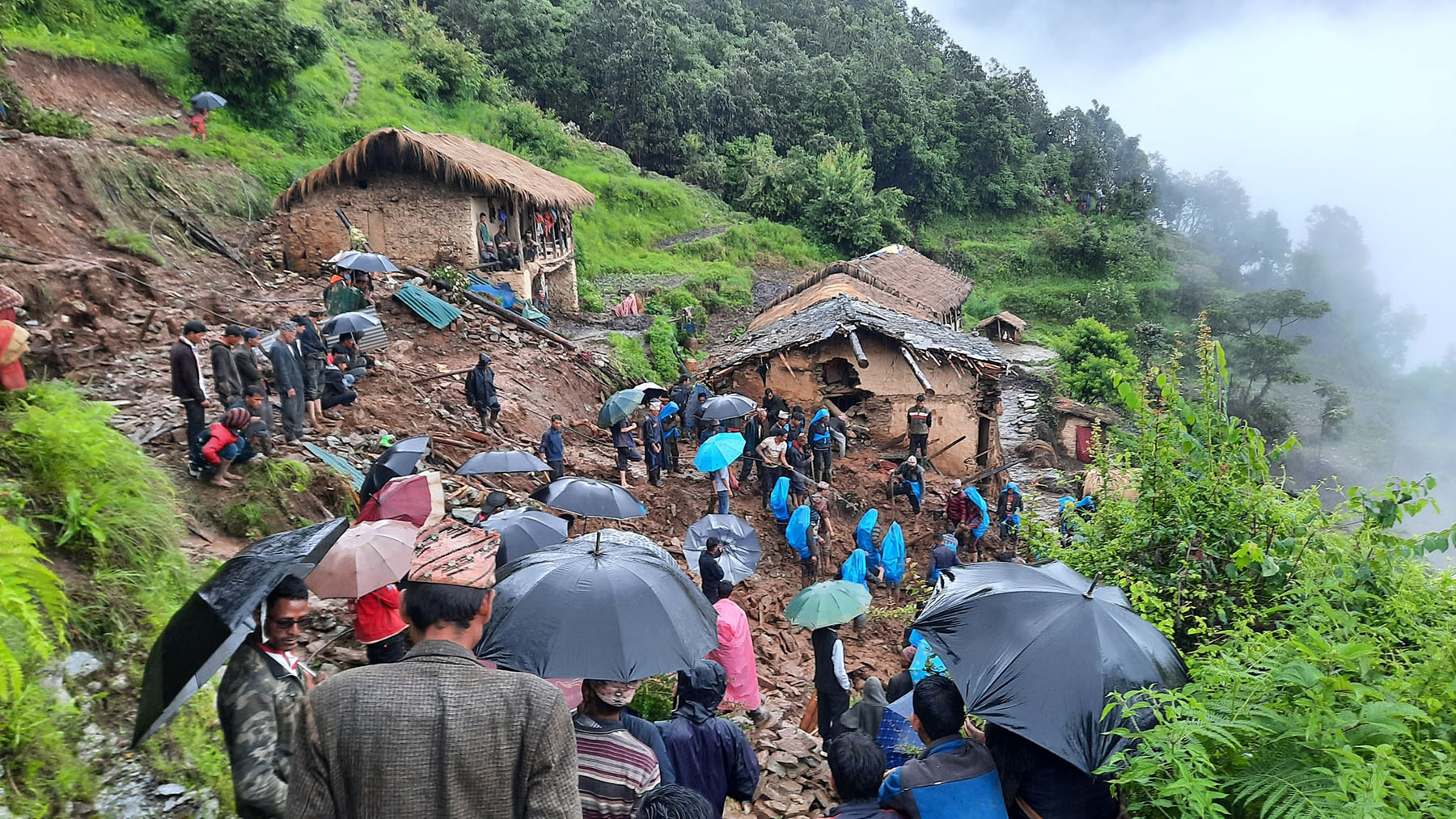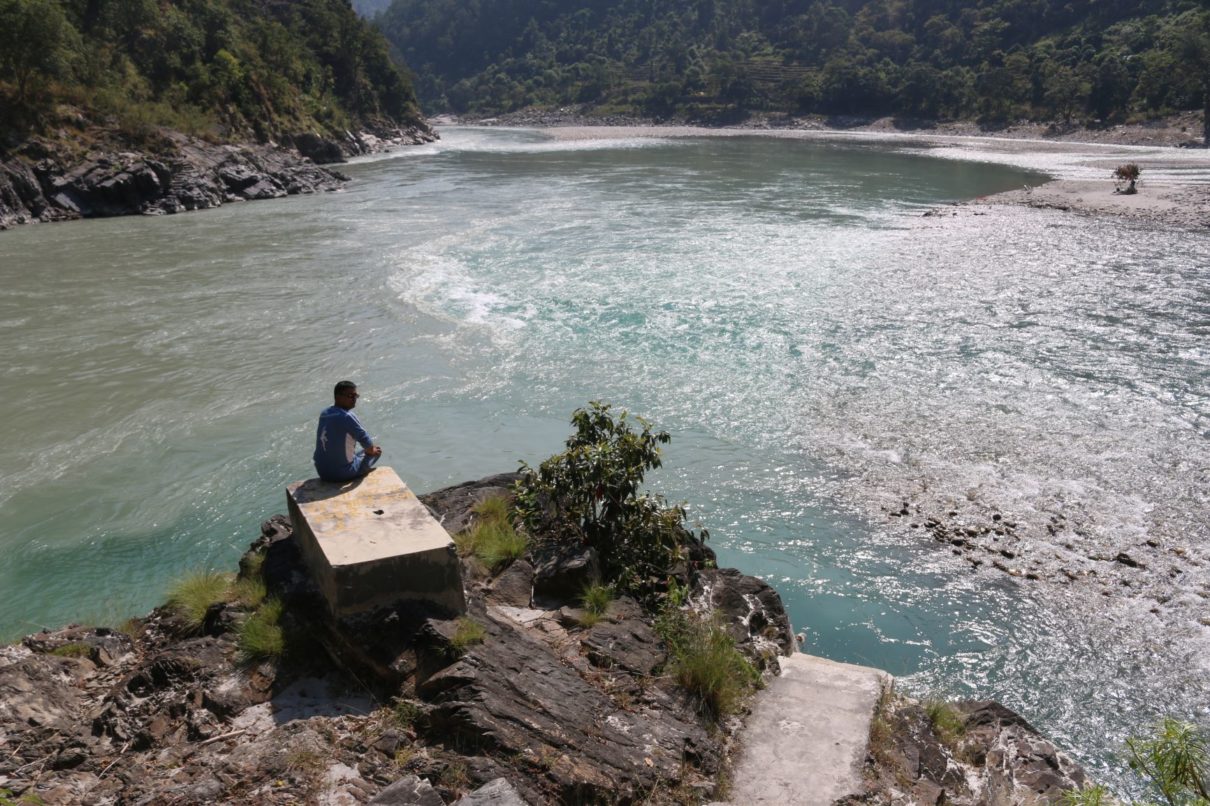Per the report, some locals from Keraunja happened to see this man caught in a massive landslide site (at Lokpa) with a span of about 800 meters taking refuge beneath boulders, on October 08. Apparently, he had been without food and water for three days. After getting this information, Sherap Gurung and his brother Tashi Dorje rushed to the site with edibles and medicine (brufen and moov) for pain relief, received from health workers with instructions for use. After giving him instructions for the use of medicine, the two locals rushed back with the victim’s fervent appeal for immediate rescue.
Apart from food, water and medicine, the stranded youth is in need of immediate rescue as his broken leg has started stinking, per the report that quoted Lama as saying that efforts to airlift him are underway. The Annapurna Post report further points, quoting Chumnubri rural municipality Chair Lama: Around 50 foreign trekkers remain stuck at Chumnubri rural municipality ward numbers 4 and 6 in the Manaslu region for four days following incessant rains that have triggered landslides. The report quotes Chair Lama: Yesterday, two helicopters rescued tourists stuck in Pewa. Around 50 still remain stuck. Talks are on with the District Administration Office, the Home Ministry and the Nepali Army for the rescue of the stranded tourists. The report quoted tourist guide Sane Gurung: Some tourists have their visas about to expire, while some others have run out of money. Most of the tourists are old. They are in dire straits. Gorkha is not the only highland district in the eye of natural disasters like rainfall and landslides, unheard of phenomena on the lap of the Himalayas even at the start of the 21st century. Rastriya Samachar Samiti reported the death of seven members of a family in an incessant rainfall-triggered landslide that buried their house at Barkotebada, Kanaksundari rural municipality-5, Jumla, on Saturday (October 08). Per the report, rainfall has blocked/damaged roads in many places in the highland district. Downhill, The Rising Nepal (TRN) reported on October 9 that floods resulting from an ‘unprecedented rainfall’ have caused significant damage to the 35 KW Inglekhola micro hydropower station in Gurja, Dhaulagiri rural municipality-1 (Myagdi district), plunging 265 households in Gurja into darkness. Per the report, rainfall has also blocked Beni-Darbang and Beni-Jomsom roads. According to the report that quoted local residents, hills near Gurja village have been experiencing snowfall since Friday morning, a never-before-seen phenomenon in the month of October, at least in the living memory of those quoted. In the southern plains of Nepal, rainfall-triggered floods have caused huge loss of lives and properties. As per a recent TRN report, a rain-swollen Narayani river has flooded over 100 houses at Baguban of Binayi Tribeni rural municipality-1 and at Seheri, Bhutaha and Prasauni in Madhyabindu municipality in East Nawalparasi district. The report quoted chair of the rural municipality, Ghana Shyam Giri: At least 70 houses have been submerged at Baguban, and over three dozen at Seheri, Bhutaha and Prasauni. Many victims at Baguban were trapped in their houses and waiting for rescue. Other districts in the plains like Bardiya, Banke, Dang, Rupandehi and West Nawalparasi are faring no better. Incessant rainfall, which triggered floods and landslides resulting in significant loss of lives and properties including in the Kathmandu Valley, is a new phenomenon for the country around this time of the year. Hile Dashain (a muddy Dashain resulting from the rains) is sometimes heard in casual conversation with elders but death and devastation of this scale towards the end of the monsoon season was quite unimaginable. The country was ill-prepared to deal with natural disasters this time as well. Once in a while, the Weather Forecast Division would issue flood alerts to local communities living close to river banks, appealing them to move to safer places. For most of the afflicted lot, those safer places were nowhere to be found. As in the disasters of the past, security personnel, spread too thin and ill-equipped, tried their level best to protect lives and properties. But the behemoth called the Nepali state, the government in particular, remained unmoved in the face of this national tragedy that turned Vijaya Dashami into a Dasha (bad luck) for the multitudes, who were already dealing with multiple maladies like chronic corruption, malgovernance, misrule, political instability, soaring inflation and plummeting standards of living. Neither the five-party coalition government, nor the opposition parties, nor the lawmakers put out words of sympathy for the victims, leave alone the hope of fraternal organizations of parties across the political spectrum joining hands with security personnel for rescue and relief distribution efforts. Busy preparing for provincial and federal elections slated for November 20, they had no time for the very country and the people they claim to be serving. Surprisingly enough, no word of sympathy came from the Presidential Palace. This silence in times of a national tragedy is an indication of the apathy of the Nepali state towards climate change and its possible impact on one of the most vulnerable countries in the world. Perhaps it is an indication that powers that be in Nepal—tried, tested, failed and corrupt beyond measure—are hell bent on letting environmental devastation continue in the holy name of development with scant regard for climate change and its impact. Their silence shows that they will keep mum in the face of rampant and illegal mining of construction materials in the Chure, in the mid-Hills and beyond as long as they get their cut. It means they will continue to allow development of roads here, there, everywhere with no regard for the carrying capacity of the local terrain. At a time of glacial retreat, glacial lake outburst flood, severe drought and rapid desertification resulting from climate change, this silence points that our good-for-nothings will continue to give a go-ahead for the construction of projects meant to rob Nepal of all her waters, export the benefits across the border and make successive generations of Nepalis pay costlier than ever environmental bill associated with these projects. Wrapping up, let’s revisit the site at Chumnubri where Dipak GC remains trapped beneath an outcrop of boulders that continues to stand somehow. Let’s revisit the site where 50 or so tourists remain stranded. Let’s do whatever we can for their rescue. Coming to the point, Nepal is no less vulnerable than GC and those tourists, caught as she is between a rock and a hard place in the context of climate change, thanks to a political leadership shorn of long-term vision for the country and the peoples it claims to be serving. Let’s join hands and work a way out to rescue the country from this trap without further delay, for the time is running out.











